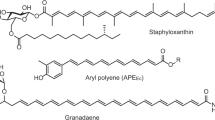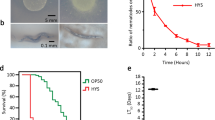Abstract
Siderophores are low-molecular-mass, high-affinity chelators of Fe3+ ions that are critical for the survival of bacteria in ferric deficient environment. Exogenous siderophores are potential bacteriostat by disrupting the iron-uptake process of pathogens. In our previous work to discover siderophores, strain LS1784 was previously predicted to produce new catecholate-type siderophores by genome analysis but no compounds were obtained. In this work, we reclassified train LS1784 as Kitasatospora sp. LS1784 according to the genome phylogenetic analysis. Then guided by CAS colorimetric assay and molecular network analysis, four catecholate-type siderophores were isolated from the ethyl acetate extract of LS1784 which were coincident with the initial prediction. Notably, compounds 2 and 3 were reported for the first time. Following activity screening, compound 3 showed sufficient anti-Pseudomonas aeruginosa-infection activity in Caenorhabditis elegans infection models, whereas all compounds exhibited no antimicrobial activity. These results indicated that compound 3 can enhance the survival of P. aeruginosa infecting C. elegans by reducing the virulence of P. aeruginosa rather than killing P. aeruginosa, which aligns with our previous findings. Moreover, these findings highlight the effectiveness of comprehensive approaches, including genome mining, CAS (Chromeazurol S) testing, and molecular network (MN) analysis, in identifying potential siderophores, thereby expanding the siderophores arsenal in bacteria for the development of anti-infective drugs.
This is a preview of subscription content, access via your institution
Access options
Subscribe to this journal
Receive 12 print issues and online access
$259.00 per year
only $21.58 per issue
Buy this article
- Purchase on Springer Link
- Instant access to full article PDF
Prices may be subject to local taxes which are calculated during checkout





Similar content being viewed by others
References
Newman DJ, Cragg GM. Natural products as sources of new drugs over the nearly four decades from 01/1981 to 09/2019. J Nat Prod. 2020;83:770–803.
Qadri H, Haseeb Shah A, Mudasir Ahmad S, Alshehri B, Almilaibary A, Ahmad Mir M. Natural products and their semi-synthetic derivatives against antimicrobial-resistant human pathogenic bacteria and fungi. Saudi J Biol Sci. 2022;29:103376.
van den Broek PJ. Antimicrobial drugs, microorganisms, and phagocytes. Rev Infect Dis. 1989;11:213–45.
Chin KW, Michelle THL, Luang-In V, Ma NL. An overview of antibiotic and antibiotic resistance. Environ Adv 2022;11:100331.
Qi YK, Tang X, Wei NN, Pang CJ, Du SS, Wang K. Discovery, synthesis, and optimization of teixobactin, a novel antibiotic without detectable bacterial resistance. J Pept Sci. 2022;28:e3428.
Dang X, Wang G. Spotlight on the selected new antimicrobial innate immune peptides discovered during 2015-2019. Curr Top Med Chem. 2020;20:2984–98.
Wang Z, Koirala B, Hernandez Y, Zimmerman M, Park S, Perlin DS, et al. A naturally inspired antibiotic to target multidrug-resistant pathogens. Nature. 2022;601:606–11.
Wang Z, Koirala B, Hernandez Y, Zimmerman M, Brady SF. Bioinformatic prospecting and synthesis of a bifunctional lipopeptide antibiotic that evades resistance. Science. 2022;376:991–6.
Dehbanipour R, Ghalavand Z. Anti-virulence therapeutic strategies against bacterial infections: recent advances. Germs. 2022;12:262–75.
Kalimuthu S, Alshanta OA, Krishnamoorthy AL, Pudipeddi A, Solomon AP, McLean W, et al. Small molecule based anti-virulence approaches against Candida albicans infections. Crit Rev Microbiol. 2022;48:743–69.
Ratledge C, Dover LG. Iron metabolism in pathogenic bacteria. Annu Rev Microbiol. 2000;54:881–941.
Miethke M, Marahiel MA. Siderophore-based iron acquisition and pathogen control. Microbiol Mol Biol Rev. 2007;71:413–51.
Bilitewski U, Blodgett JAV, Duhme-Klair AK, Dallavalle S, Laschat S, Routledge A, et al. Chemical and biological aspects of nutritional immunity-perspectives for new anti-infectives that target iron uptake systems. Angew Chem-Int Ed. 2017;56:14360–82.
Xie F, Dai SW, Zhao Y, Huang P, Yu S, Ren B, et al. Generation of fluorinated amychelin siderophores against Pseudomonas aeruginosa infections by a combination of genome mining and mutasynthesis. Cell Chem Biol. 2020;27:1532–43.
Kautsar SA, Blin K, Shaw S, Weber T, Medema MH. BiG-FAM: the biosynthetic gene cluster families database. Nucleic Acids Res. 2021;49:D490–7.
Bankevich A, Nurk S, Antipov D, Gurevich AA, Dvorkin M, Kulikov AS, et al. SPAdes: a new genome assembly algorithm and its applications to single-cell sequencing. J Comput Biol. 2012;19:455–77.
Aziz RK, Bartels D, Best AA, DeJongh M, Disz T, Edwards RA, et al. The RAST Server: rapid annotations using subsystems technology. BMC Genom. 2008;9:75.
Blin K, Shaw S, Steinke K, Villebro R, Ziemert N, Lee SY, et al. antiSMASH 5.0: updates to the secondary metabolite genome mining pipeline. Nucleic Acids Res. 2019;47:W81–7.
Emms DM, Kelly S. OrthoFinder: phylogenetic orthology inference for comparative genomics. Genome Biol. 2019;20:238.
Chun J, Oren A, Ventosa A, Christensen H, Arahal DR, da Costa MS, et al. Proposed minimal standards for the use of genome data for the taxonomy of prokaryotes. Int J Syst Evol Microbiol. 2018;68:461–6.
Thorell K, Meier-Kolthoff JP, Sjöling Å, Martín-Rodríguez AJ. Whole-genome sequencing redefines Shewanella taxonomy. Front Microbiol. 2019;10:1861.
Retamal-Morales G, Mehnert M, Schwabe R, Tischler D, Zapata C, Chávez R, et al. Detection of arsenic-binding siderophores in arsenic-tolerating Actinobacteria by a modified CAS assay. Ecotoxicol Environ Saf. 2018;157:176–81.
Frisch MJ, Trucks GW, Schlegel HB, Scuseria GE, Robb MA, Cheeseman JR, et al. Gaussian 16, Revision C.01. In: Gaussian I (ed): Wallingford CT, 2019.
Grimblat N, Zanardi MM, Sarotti AM. Beyond DP4: an improved probability for the stereochemical assignment of isomeric compounds using quantum chemical calculations of NMR shifts. J Org Chem. 2015;80:12526–34.
Aoyagi T, Hatsu M, Kojima F, Hayashi C, Hamada M, Takeuchi T. Benarthin - A new inhibitor of pyroglutamyl peptidase. 1. Taxonomy, fermentation, isolation and biological-activities. J Antibiot. 1992;45:1079–83.
Hatsu M, Naganawa H, Aoyagi T, Takeuchi T. Benarthin - A new inhibitor of pyroglutamyl peptidase. 2. Physicochemical properties and structure determination. J Antibiot. 1992;45:1084–7.
Hatsu M, Tuda M, Muraoka Y, Aoyagi T, Takeuchi T. Benarthin - A new inhibitor of pyroglutamyl peptidase. 3. synthesis and structure-activity-relationships. J Antibiot. 1992;45:1088–95.
Xu ZX, Li B, Tian Y, Li M, Dong JX, Zhang GJ. Chemical constituents from the aerial parts of Orychophragmus violaceus. Nat Prod Res. 2022;5:1–9.
Hider RC, Kong X. Chemistry and biology of siderophores. Nat Prod Rep. 2010;27:637–57.
Barry SM, Challis GL. Recent advances in siderophore biosynthesis. Curr Opin Chem Biol. 2009;13:205–15.
Timofeeva AM, Galyamova MR, Sedykh SE. Bacterial siderophores: classification, biosynthesis, perspectives of use in agriculture. Plants. 2022;11:3065.
Kirienko NV, Kirienko DR, Larkins-Ford J, Wählby C, Ruvkun G, Ausubel FM. Pseudomonas aeruginosa disrupts Caenorhabditis elegans iron homeostasis, causing a hypoxic response and death. Cell Host Microbe. 2013;13:406–16.
Acknowledgements
Dr. Jinwei Ren and Dr. Wenzhao Wang (State Key Laboratory of Mycology, Institute of Microbiology, Chinese Academy of Sciences) are appreciated for their help in measuring the NMR and MS data. This work was supported in part by the National Natural Science Foundation of China grant 22277135 and 82073723.
Author information
Authors and Affiliations
Corresponding authors
Ethics declarations
Conflict of interest
The authors declare no competing interests.
Additional information
Publisher’s note Springer Nature remains neutral with regard to jurisdictional claims in published maps and institutional affiliations.
Supplementary information
Rights and permissions
Springer Nature or its licensor (e.g. a society or other partner) holds exclusive rights to this article under a publishing agreement with the author(s) or other rightsholder(s); author self-archiving of the accepted manuscript version of this article is solely governed by the terms of such publishing agreement and applicable law.
About this article
Cite this article
Chen, B., Wang, Y., Xie, F. et al. Identification of siderophores blocking infection of Pseudomonas aeruginosa from Kitasatospora sp. LS1784. J Antibiot 77, 4–12 (2024). https://doi.org/10.1038/s41429-023-00675-2
Received:
Revised:
Accepted:
Published:
Issue Date:
DOI: https://doi.org/10.1038/s41429-023-00675-2



